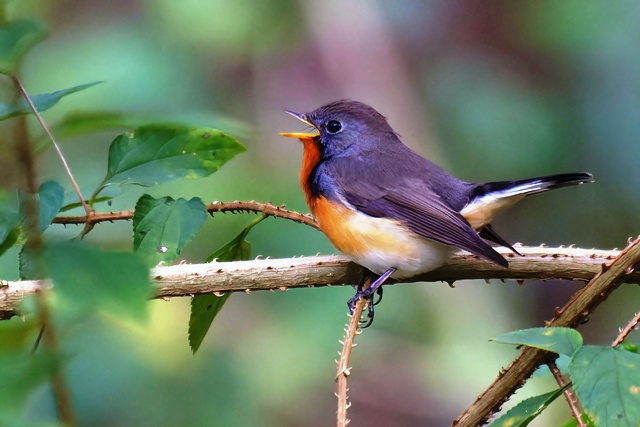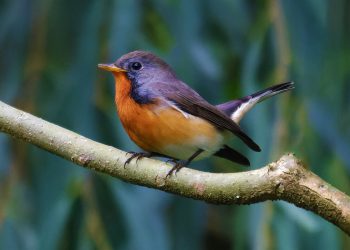Kashmir Flycatcher (Ficedula subrubra) is an endemic to the Indian Subcontinent with a very restricted breeding and wintering range.
The Kashmir flycatcher (Ficedula subrubra ) is a small passerine bird in the flycatcher family Muscicapidae. At one time it was considered to be a subspecies of the red-breasted flycatcher, Ficedula parva.
This is an insectivorous species which breeds in the north-west Himalayas in the Kashmir region of the Indian Subcontinent. It is migratory and winters in the hills of central Sri Lanka and the Western Ghats of India.
The Kashmir flycatcher breeds in deciduous forest with dense undergrowth, nesting in a hole in a tree and laying 3-5 eggs which are incubated by the female. It winters in gardens, tea estates, forest edges, and open areas within forest, generally above 750 m approximately.
The male has a grey-brown back with an orange-red throat, breast and flanks, bordered with black on the throat and breast. Females and first-winter birds have slightly browner upperparts, and the red of the underparts may be reduced to just a pinkish wash.
The male of the similar taiga flycatcher, Ficedula albicilla, has the reddish-orange area limited to the throat and the top of the breast, and lacks the black border.
The song is a short melodic sweet-eet sweet-eet-did-he, and the call is a sharp chak.
This is a vulnerable species with a decreasing population and breeding range, which is also severely fragmented as a result of the destruction of temperate mixed deciduous forests by commercial timber extraction, agriculture and livestock grazing.
This was photographed at Ooty, Tamil Nadu, India.

These rare photographs have been clicked and contributed by K. Shiva Kumar, a professional Wildlife Storyteller (M.A in Journalism & Mass Communication, an alumnus of Central University Of Odisha, Koraput) from Hyderabad, Telangana.


